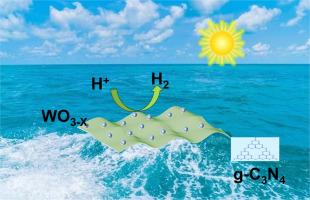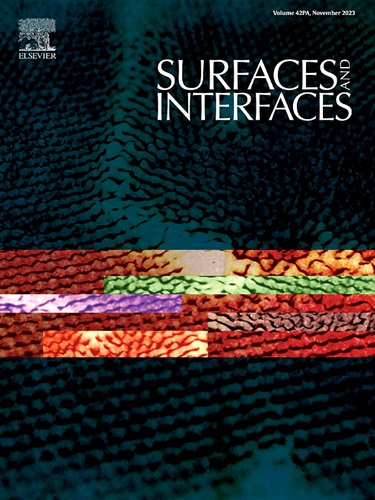构建缺氧 WO3-x 和 g-C3N4 的 Z 型异质结,实现卓越的 H2 光催化进化能力
IF 5.7
2区 材料科学
Q2 CHEMISTRY, PHYSICAL
引用次数: 0
摘要
基于半导体的光催化水分离技术可将丰富的太阳能转化为绿色可再生氢能。氮化石墨碳(g-C3N4)是用一种简单的方法合成的,具有稳定的物理化学特性和最佳带隙,因此在环境可持续发展领域是一种很有前途的光催化剂。氧空位被广泛用于调节金属氧化物半导体的光吸收和表面特性。在这项研究中,g-C3N4 纳米片与缺氧的三氧化钨(WO3-x)结合形成了异质结光催化剂(X-WOCN)。综合材料表征结果表明,所构建的异质结扩大了可见光吸收范围,提高了光生电子-空穴分离效率,从而增强了光催化活性。值得注意的是,与 g-C3N4 相比,6%-WOCN 的最佳氢进化率提高了 5.4 倍。此外,我们还提出了一种由氧缺陷介导的 Z 型异质结电荷分离机制,并通过检测表面活性物质 -O2- 和 -OH 支持了这一机制。这项研究为氧缺陷在促进 Z 型异质结电荷分离方面的功能提供了新的命题。本文章由计算机程序翻译,如有差异,请以英文原文为准。

Constructing a Z-scheme heterojunction of oxygen-deficient WO3-x and g-C3N4 for superior photocatalytic evolution of H2
Semiconductor-based photocatalytic water splitting enables the conversion of abundant solar energy to green and renewable hydrogen energy. Graphitic carbon nitride (g-C3N4) is synthesized using a straightforward method, demonstrating stable physicochemical properties and possessing an optimal bandgap, thus positioning it as a promising photocatalyst in the realm of environmental sustainability. Oxygen vacancies are extensively employed to modulate light absorption and surface properties of metal-oxide semiconductors. In this study, g-C3N4 nanosheets were coupled with oxygen-deficient tungsten trioxide (WO3-x) to form heterojunction photocatalysts (X-WOCN). Comprehensive material characterization results demonstrated that the constructed heterojunction extended the visible light absorption range, improved photogenerated electron-hole separation efficiency, and thus augmented photocatalytic activity. Notably, the optimum hydrogen evolution rate of 6 %-WOCN was enhanced by 5.4-fold compared to that of g-C3N4. Furthermore, we propose a Z-scheme heterojunction charge separation mechanism mediated by oxygen defects and support this mechanism through detection of surface-active substances •O2− and •OH. This study offers novel propositions into the function of oxygen defects in facilitating charge separation within Z-scheme heterojunction.
求助全文
通过发布文献求助,成功后即可免费获取论文全文。
去求助
来源期刊

Surfaces and Interfaces
Chemistry-General Chemistry
CiteScore
8.50
自引率
6.50%
发文量
753
审稿时长
35 days
期刊介绍:
The aim of the journal is to provide a respectful outlet for ''sound science'' papers in all research areas on surfaces and interfaces. We define sound science papers as papers that describe new and well-executed research, but that do not necessarily provide brand new insights or are merely a description of research results.
Surfaces and Interfaces publishes research papers in all fields of surface science which may not always find the right home on first submission to our Elsevier sister journals (Applied Surface, Surface and Coatings Technology, Thin Solid Films)
 求助内容:
求助内容: 应助结果提醒方式:
应助结果提醒方式:


